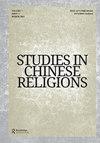A study on a stone lantern from Dongzhang village in medieval China
IF 0.3
3区 哲学
0 ASIAN STUDIES
引用次数: 1
Abstract
ABSTRACT The lamp platform was one of the most interesting architectural designs in medieval Chinese Buddhism. Its history could be dated back to the late Northern dynasties and Shanxi area could be the place where it was invented. In the Tang dynasty, stone lamp platforms became flourishing in North China. As a Buddhist center in the medieval period, Mount Wutai attracted numerous pilgrims and it developed very rich and diverse Buddhist culture. Interestingly, one stone lamp platform from this area survived today. It was first commissioned in the Kaiyuan period in the early eighth century by a group of Buddhist adherents under the leadership of two Buddhist masters and renovated in the Song dynasty, in 997 by local Buddhist patrons. The inscription written by Zhang Chuzhen is mostly extant, which offers us an opportunity of understanding the historical context in which this platform was constructed. This article aims to examine the significance of this lamp platform by looking into its position with a comparison with other lamp platforms discovered in Shanxi area. It will investigate the Buddhist connections between Mount Wutai and Taiyuan, as well as the Ye City by reading a group of lamp platforms in these areas as a monastic network. In the meantime, given that the Shanxi area was a stronghold of Zoroastrians from Central Asia in the medieval period as recent archeological findings demonstrate, this article will attempt to analyze the rituals of lighting lamp platforms in Buddhism and worshipping fire temples in Zoroastrianism from cross-cultural and cross-religious perspectives.中国中世纪东张村石灯研究
灯台是中国中世纪佛教中最有趣的建筑设计之一。它的历史可以追溯到北朝晚期,山西地区可能是它的发源地。唐代时,石灯台在华北盛行。作为中世纪的佛教中心,五台山吸引了众多的朝圣者,发展了非常丰富多样的佛教文化。有趣的是,这个地区的一个石灯台保存至今。它最初是在公元8世纪初开元时期由一群佛教信徒在两位佛教大师的领导下委托建造的,并于公元997年由当地佛教赞助人在宋代修缮。张楚真的题词大多存世,这为我们提供了一个了解这个平台建造的历史背景的机会。本文旨在通过与山西地区发现的其他灯台的比较,探讨该灯台的地位和意义。它将通过阅读这些地区的一组灯台作为寺院网络来研究五台山与太原以及邺城之间的佛教联系。同时,鉴于最近的考古发现表明,山西地区在中世纪时期是中亚琐罗亚斯德教的据点,本文将尝试从跨文化和跨宗教的角度分析佛教的点灯平台和琐罗亚斯德教的火庙崇拜仪式。
本文章由计算机程序翻译,如有差异,请以英文原文为准。
求助全文
约1分钟内获得全文
求助全文
来源期刊

Studies in Chinese Religions
Arts and Humanities-Religious Studies
CiteScore
0.20
自引率
0.00%
发文量
10
 求助内容:
求助内容: 应助结果提醒方式:
应助结果提醒方式:


